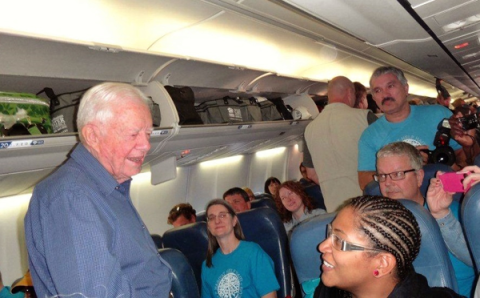
The arduous progress has once again made the concept of donor fatigue a headline. But, for all of us, the moral danger lies in letting that concept become commonplace. The situation is still dire, but the recovery that is happening, although slow, is affecting Haitians in a positive way.
It’s that motivator — the refusal to throw up one’s hands and do nothing because it seems like nothing can be done — that drove Warner/Chappell Music Canada general manager Vivian Barclay to return to Haiti as part of Habitat for Humanity’s Jimmy & Rosalynn Carter Work Project this past November.
The former U.S. President’s annual home-building project traditionally alternates between stateside and international build,s but the need in Haiti was so great, the project returned for two consecutive years. Barclay was on both builds.
She shared her experience with Samaritanmag. During the conversation, the Toronto-based music publishing exec spoke candidly and passionately about Habitat’s commitment to understanding and meeting the specific needs on the ground, such as land tenure issues. She confronted the harsh reality that the donor community can find certain needs desirable vs. undesirable, which can hinder fundraising efforts (i.e. garbage and debris removal is not a “sexy” issue). And, on a personal note, she acknowledged the legacy and influence of her mother on her own desire to give back and looked forward to Habitat for Humanity’s upcoming builds on reservations in Canada.
Below, in her own words, she sheds light on the progress being made on the ground, the major role Canada has played and the philanthropic roles that anyone — even you — can take.
![]()
![]()
![]()
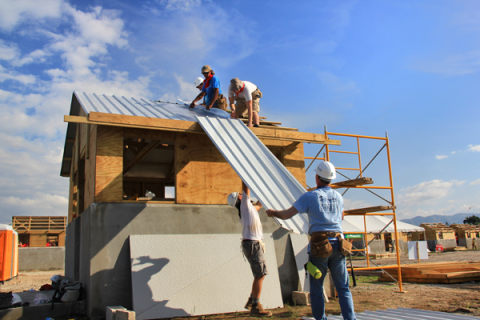
It turned out that my company, Warner Music Group, is a supporter of Habitat in the States and because of their donation they were awarded four spots on the first build, the Jimmy & Rosalynn Carter Work Project, in 2011. They put out a call to staff to apply for those four spots. I applied and told them about my background with Habitat in Toronto — I served as a Toronto Women Build ambassador, the fact that being from the region I felt like it hit close to home, and that I wanted to be able to show the people of Haiti that the people in the region were thinking about them and wanted to come over and help them.
We completed 100 homes in seven days in a community called Santo in Léogâne, Haiti, which was at [the earthquake’s epicenter]. It had been almost two years since the earthquake and 400,000 people were still living in tents. This year, it’s three years after the fact and there’s probably just under 300,000 people in tents.
So, there’s still a big need and having Habitat and other groups, like [Irish NGO] Haven, come back to Haiti continues to shed light on the situation, because a couple years have passed, other disasters happened… Hurricane Sandy happened, and people just move on from the story, thinking: Things must have gotten better by now. We forget that progress is sometimes just extremely slow. After we left last year most of us were like: ‘I have to come back and see this through.’
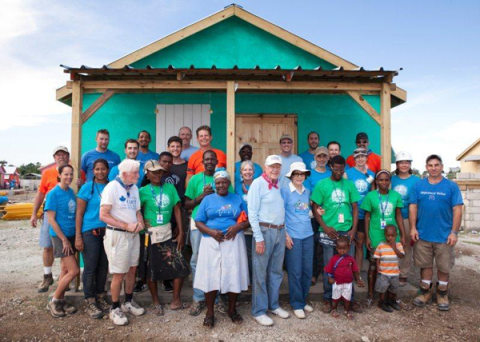
The people we met from Habitat Haiti were thanking Canadians left, right and centre. Not just the ones that were there with Habitat, but Canadians in general. They said they really appreciate the close relationship they have with Canada. The work isn’t done and they hope we’ll continue in the region. Our work is making a difference whether you donated five bucks, 20 dollars or whether you went there — whatever you did as a Canadian, trust me it’s being used well if you donated to a reputable organization, like Habitat, MSF [Doctors Without Borders] and Red Cross.
When we arrived, I said to my seat mate: ‘Last time we came here it was so discouraging to drive out to the Port-au-Prince airport and five minutes out you see a huge stretch of land densely packed with tarp-like tents.’ To be quite frank, I fully expected to come out of the airport and see the exact same thing. But the tent city, which was in the most precarious place, was gone. The major reason for its removal was in direct relation to Canadian support in Haiti. There are still a lot of tent cities there, but that one was gone from one year to the next.
To see the progress that was made and to see that there were work projects that had been completed: streets and sidewalks fixed, attempts to start the beautification of the elements in between the roads, buildings starting to be constructed, and the fact that a lot of the garbage and debris piles had been cleared up.
Is it perfect? No. When you have two hundred odd thousand people still in tent cities — that’s a problem. Some people might look at Habitat, Haven, Food for the Poor Jamaica or any of the groups that are there actively trying to build and say, ‘Oh, it’s a drop in the bucket.’ But, at the end of the day, it’s a drop in the bucket that’s necessary.
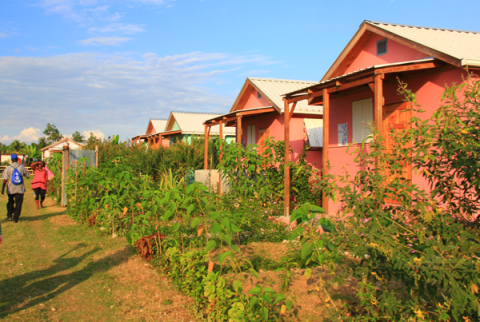
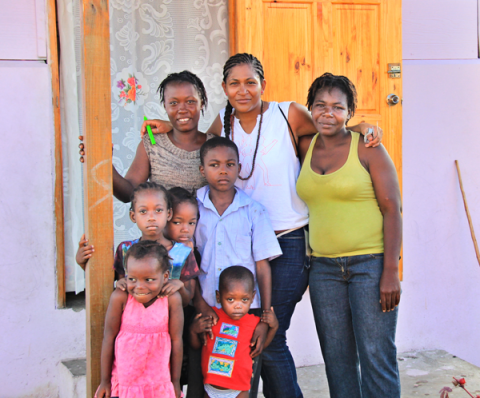
A lot of people lost family in the earthquake or they were already in charge of extended families. So some of these homes had 10 people. You’re not just taking one person out of a tent and putting them into a house. You’re possibly taking over five to 10 people out of a tent situation and putting them into a permanent housing situation. What comes out of that is that they get to go to school; they get to have a stable place to live; they get clean water. All of these things become a trickle-down effect for the community and starts to make a huge difference in their lives. So, is that really a drop in the hat?
For the most part, people want to get involved, but the attitude of a lot of people is that they don’t think they have enough money to help or they don’t know what to do. They feel overwhelmed by it all. I have people come up to me all the time and say: ‘I so wish I could do what you’re doing.’ And I’m like: ‘Well you can, there’s nothing stopping you.’ I’m not rich by any stretch of the imagination. But we all have the ability to fundraise and donate our time and voices for issues that are important to us. I just really looked at it and went: ‘What can I do in my own little space: one, I can walk; two, I can donate; three, I can swing a hammer.’
You don’t have to be a professional at it, but you do have to come to it from the right place in your mind. Not because you’re looking for the accolades and not because you’re feeling guilty because you live in what we call the ‘First World’ and we have our ‘First World Problems.’ There were times when the locals looked at us and you can tell they were happy to see us, because you know how many times these people have been told that someone’s coming to help and nothing changes for them?
But I think some volunteers were taken aback because they thought, I’m going to do this good deed and the people are going to love me, and you have to understand that the person you’re helping is not necessarily giving a hoot about your altruistic notions. They’re not negative toward you, but they’re just trying to figure out how they’re going to eat, where they’re going to sleep, how they’re going to find some water.
But if you genuinely have a place where you feel like you have something to give then go forth and see what organizations do the work that you think is important.”
Fullress , スニーカー発売日 抽選情報 ニュースを掲載!ナイキ ジョーダン ダンク シュプリーム SUPREME 等のファッション情報を配信!